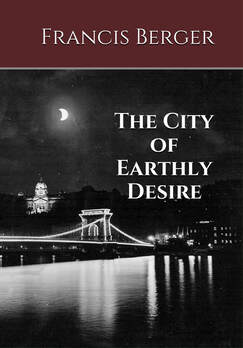I spent much time in Budapest as a child, and as a young adult I was fortunate enough to witness Budapest shake off its communist oppression and begin its renewal. Of course, this renewal was not without its trials and tribulations as the turbulent and tempestuous assault of unconstrained liberty drowned the city in feverish impulses and ruthless ambitions. Budapest of the 1990s and early 2000s was indeed a City of Earthly Desire, its streets marred by poverty, homelessness, and crude businesses that exploited the upended social structure and lured many of the country’s inhabitants to sell their souls in exchange for financial gains. These forces were dissipating when I lived in the city from 2001 to 2003, but the ill effects of the hyper-liberalization that filled the vacuum communism had left behind could still be felt, and I drew much inspiration for my novel The City of Earthly Desire from the two years I spent living in Budapest.
Before moving back to Hungary in 2015, I considered settling in Budapest again, but after having spent most of my life living in or extremely close to big cities – Toronto, New York, and of course Budapest – I had little desire to reside in an urban center again, especially after the rather pleasant experience of living in a small rural town in northern England. Hence, I turned my back on the possibility of Budapest and settled instead in a small village near a minor provincial city near the Austrian border. Though I have been to Budapest many times since moving back to Hungary nearly four years ago – mostly visiting relatives who live in the suburbs and outskirts of the city – my forays into the city itself were few and brief. I could feel the city’s magnetic pull, but I was reluctant to spend any significant amount of time wandering through its streets and reacquainting myself with its charms. I don’t know what the source of the reluctance was. Was I afraid of what I might find there, or did I simply wish to preserve the city that existed in my memory?
Fast-forward to 2018 and after my brief two-day visit I can proclaim that Budapest continues on its seemingly endless transformation from a capital debased by communism to a city that has recaptured and may even surpass its former glory. At the surface level, Budapest has never looked so good. Many buildings have been refurbished or rebuilt; the bridges gleam as they stretch across the Danube; the public squares are both tidy and inviting. The grime and soot that previously besmirched landmarks such as the Parliament Buildings and the Buda Palace is gone. Streamlined streetcars and busses have replaced the noisy, ramshackle public transportation vehicles of the past. As I walked through the city with my wife, I was overcome with wonder and admiration at the transformation that had taken place since we had moved away from the city, but the more we walked, the more my admiration became tempered by mild displeasure.
An unsettling form of over-cosmopolitanism has settled down inside the city’s refurbished exterior, especially within Districts V, VI, and VII. Here one can walk for blocks without hearing a single word of spoken Hungarian or seeing a single storefront sign that is exclusively written in the country’s language. The sidewalks here throng with tourists of every shape, form, and age – young Brits out on a boisterous pub crawl, kitschy Russians and Ukrainians sauntering past the marquee stores lining Andrássy Street, timid Japanese shuffling about the Parliament, groups of bewildered American retirees overwhelmed by the hustle of a guided city tour, and everyone else one can imagine mixed in among these crowds sloshing through the streets like ceaseless, almost liquid, human waves.
The amenities in these districts cater almost exclusively to Budapest’s international visitors – trendy burger restaurants, sushi stands, fusion cuisine bistros, burrito bars, and glorified street food venues have replaced the often grimy, but delightful eateries than once lined these sidewalks. You can enter one of these new restaurants and encounter serving staff who speak no Hungarian, and chances are even the native-speaking staff will greet you in English when you walk in the door. Concentrated between these eateries are the many bars, nightclubs, and drinking establishments where the price of a beer is easily triple what you would pay for one in another part of the city. And of course there are the boutique hotels, the designer stores, the high-end beauticians and barber shops, and the trendy clothing shops.
I walked past these establishments and tried to imagine the amount of money all the tourists milling around spent and how positive that undoubtedly was for the local economy. The only problem was I had a craving for a good, old-fashioned bowl of gulyás soup while I thought of these things, but I could not for the life of me find a simple Hungarian restaurant and ended up settling for an overpriced, modish goose meat hamburger instead. As my wife and I walked back to our hotel, I cast glances up at the apartment windows above the many rowdy bars, glitzy souvenir shops, and chic eateries and wondered how the locals felt about it all, assuming there were any locals left in those apartments. For all I knew, the lit windows might now be Air BNBs.
Overtourism is a difficult concept to define because it is hard to set the parameters delineating it, but I would hazard to guess that Budapest has morphed from being The City of Earthly Desire to a City of Overtourism. If I had to choose, I would find the latter preferable to the former, but that does not imply that the rampant overtourism Budapest is now experiencing is not without its pitfalls. Statistics show Hungary welcomed well over 50 million tourists last year; that works out roughly to five tourists for every citizen. I imagine at least two-thirds of the 50 million visited Budapest exclusively, which would put the tourist-to-local ratio somewhere in the ten-to-one or perhaps even the twenty-to-one range.
Now there is no denying the vast economic benefits tourism can bring to a city or a country, but I cannot help but wonder what some of the drawbacks might be, especially over the long term, and whether the short-term benefits are worth the long term negatives. Whatever the case may be, I humbly assert Budapest needs to be careful – another decade of the kind of hyper-tourism I witnessed may transform the city into nothing more than an urban playground for budget-airline party seekers and the global well-to-do.
And that would be a shame, to say the least.

 RSS Feed
RSS Feed

